INTENDED FOR US HEALTHCARE PROFESSIONALS
Osteoporosis is a chronic disease, and breaking a bone can be a life-altering event1,2
About 54 million
Americans have osteoporosis and low bone mass3
About 54
million Americans have osteoporosis and low bone mass3

84%
of women with postmenopausal osteoporosis who experienced a fracture were not treated for the underlying disease of osteoporosis within 6 months, according to a survey of an integrated healthcare delivery system in Washington State5,*
*Survey conducted by Group Health Cooperative that provides comprehensive healthcare to ~ 600,000 individuals in Washington State.
Data based on women aged 55 and older who experienced an osteoporosis-related fracture from January 1, 2013, to March 30, 2014.
Osteoporosis is a common disease.3 In a year, osteoporosis-related fractures in the United States led to:4,*
 > 500,000 hospital admissions
> 500,000 hospital admissions  ~ 2.6 million medical office visits
~ 2.6 million medical office visits  ~ 180,000 nursing home admissions
~ 180,000 nursing home admissions *Data from Bone Health & Osteoporosis: A Report of the Surgeon General, published in 2004.
†Data represent a population-based study of 4,140 postmenopausal women aged 50-80 years.
‡Data based on a retrospective claim-based study, which assessed 1-year medical costs associated with second fracture(s) for patients over 50 years old with an initial closed hip, clinical vertebral, or nonhip nonvertebral fracture using 2002-2008 MarketScan® Commercial Claims and Encounters and Medicare Supplemental and Coordination of Benefits databases.
§Estimates based on microsimulation forecasting model to project annual incidence and costs in women aged > 65 years. Validated Fracture Risk Assessment Tool (FRAX™) tables and insights from the National Health and Nutrition Examination Survey (NHANES) were used to estimate the future burden among Medicare-eligible women. Direct costs following a fracture were based on a claims analysis, differed by category (eg, inpatient, outpatient, emergency department, long-term care, pharmacy costs following a fracture, and other), and differed for individuals experiencing a single fracture within a year versus those with a subsequent fracture. Indirect societal costs related to productivity losses and informal caregiving were included in calculating the total annual cost.
An osteoporosis diagnosis is made when a patient presents with:11
When the initial diagnosis of osteoporosis is made based on a T-score of -2.5 or below, the diagnosis persists even when a subsequent DXA measurement shows a T-score better than -2.5.11
The AACE/ACE Osteoporosis Guidelines stratify patients as high risk for fracture or very high risk for fracture to help determine initial treatment choice and duration.11 Bone builders and certain antiresorptives should be considered as initial therapy options for patients at very high risk for fracture.11 Patients are considered to be at very high risk for fracture if they have any of the following risk factors:11
 Recent fracture (e.g., within the last 12 months)
Recent fracture (e.g., within the last 12 months)  Fractures while on approved osteoporosis therapy
Fractures while on approved osteoporosis therapy  Multiple fractures
Multiple fractures  Fractures while on drugs that may cause skeletal harm
Fractures while on drugs that may cause skeletal harm  Very low T-score (e.g., < -3.0), OR very high fracture probability by FRAX™ (e.g., major osteoporotic fracture > 30%, hip fracture > 4.5%)
Very low T-score (e.g., < -3.0), OR very high fracture probability by FRAX™ (e.g., major osteoporotic fracture > 30%, hip fracture > 4.5%)  High fall risk or history of injurious falls
High fall risk or history of injurious falls Upon discontinuation of a bone builder, it is recommended to use an antiresorptive to prevent bone density decline and loss of fracture efficacy.11
References: 1. Cosman F, de Beur SJ, LeBoff MS, et al. Clinician’s Guide to Prevention and Treatment of Osteoporosis. Osteoporos Int. 2014;25:2359-2381. 2. National Osteoporosis Foundation. Clinician’s Guide to Prevention and Treatment of Osteoporosis. Washington, DC: National Osteoporosis Foundation; 2014. 3. Bone Health & Osteoporosis Foundation website. What is osteoporosis and what causes it? Accessed February 15, 2022. https://www.bonehealthandosteoporosis.org/patients/what-is-osteoporosis/. 4. U.S. Department of Health and Human Services. Bone Health & Osteoporosis: A Report of the Surgeon General. Rockville, MD: U.S. Department of Health and Human Services, Office of the Surgeon General, 2004. 5. Boudreau DM, Yu O, Balasubramanian A, et al. A survey of women’s awareness of and reasons for lack of postfracture osteoporotic care. JAGS. 2017;65:1829-1835. 6. van Geel TACM, van Helden S, Geusens PP, Winkens B, Dinant G-J. Clinical subsequent fractures cluster in time after first fractures. Ann Rheum Dis. 2009;68:99-102. 7. Song X, Shi N, Badamgarav E, et al. Cost burden of second fracture in the US health system. Bone. 2011;48:828-836. 8. Lewiecki EM, Ortendahl JD, Vanderpuye-Orgle J, et al. Healthcare policy changes in osteoporosis can improve outcomes and reduce costs in the United States. JBMR Plus. 2019;3:1-7. 9. Curtis JC, Silverman SL. Commentary: The five Ws of a fracture liaison service: why, who, what, where and how? In osteoporosis, we reap what we sow. Curr Osteoporos Rep. 2013;11. doi:10.1007/s11914-013-0177-9. 10. Wu C-H, Tu S-T, Chang Y-F, et al. Fracture liaison services improve outcomes of patients with osteoporosis related fractures: a systematic literature review and meta-analysis. Bone. 2018;111:92-100. 11. Camacho PM, Petak S, Binkley N, et al. American Association of Clinical Endocrinologists/American College of Endocrinology Clinical Practice Guidelines for the Diagnosis and Treatment of Postmenopausal Osteoporosis-2020 Update. Endocr Pract. 2020;26(suppl 1):1-46.